NASA APOD #48-56
#48 Liftoff of Space Shuttle Columbia August 06, 1995
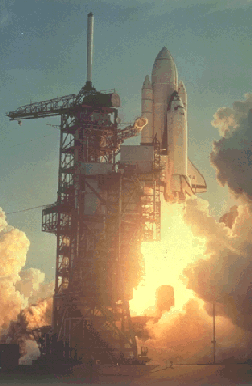
“August 6, 1995 Liftoff of Space Shuttle Columbia Credit: NASA, Kennedy Space Center Explanation: On April 12, 1981, space flight entered a new era with the first launch of Space Shuttle Columbia, shown above. NASA's Space Shuttles land like a normal plane, carry a heavy cargo, carry a large crew, make use of cheap solid fuel, and are reusable. Previous to this flight, no manned orbiting space ship had ever landed on a runway. Space Shuttles now are the flagships and the workhorses of NASA's space going rockets. For more information about NASA's Space Shuttle missions, see the NASA Space Shuttle Launches page."
Copyright: Public domain
#49 Night Launch of Endeavour August 07, 1995
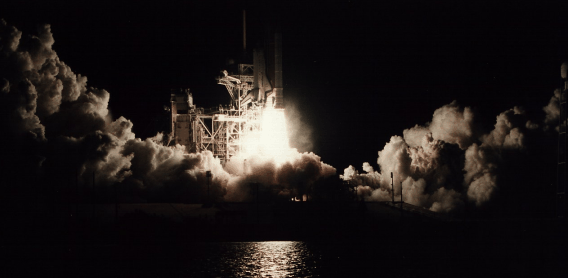
“August 7, 1995 Night Launch of Endeavour Credit: NASA, Kennedy Space Center Explanation: Space Shuttle Endeavour thunders off into orbit in a rare night launch. This March 1995 mission is most famous for operating the set of astronomical telescopes known as Astro-2. Astro-2's telescopes observed the universe in ultraviolet light - light so blue humans by themselves can't see it. Astro-2 measured the amount of ultraviolet light emitted by several interesting stars, galaxies, planets, and QSOs. Analysis of data from this NASA mission has yielded the first clear detection of helium created during the beginning of the universe. For more information about NASA's Space Shuttle missions, see the NASA Space Shuttle Launches page."
Copyright: Public domain
#50 Columbia Waits, Discovery Launches August 08, 1995
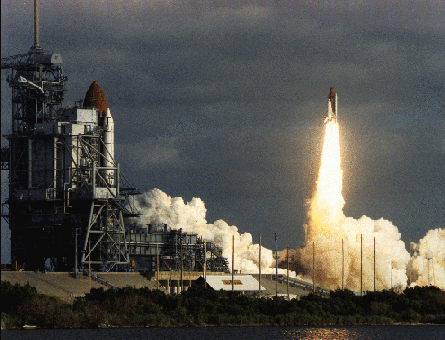
“August 8, 1995 Columbia Waits, Discovery Launches Credit: NASA, Kennedy Space Center Explanation: Space Shuttle Discovery launches while the Space Shuttle Columbia is readied for a future mission. Space shuttles are launched from the Kennedy Space Center in Florida. At this date there are four operating space shuttles: Atlantis, Columbia, Discovery, and Endeavour. This mission is most famous for carrying the Hubble Space Telescope into orbit. The Hubble Space Telescope is the largest public optical telescope ever to operate in orbit, and because it is above Earth's atmosphere it's photographs are more clear than any ground based telescope. Hubble continues to make fundamental discoveries about planets, stars, galaxies, comets, QSOs, and the universe we live in."
Copyright: Public domain
#51 Challenger Launches Spacelab 2 August 09, 1995
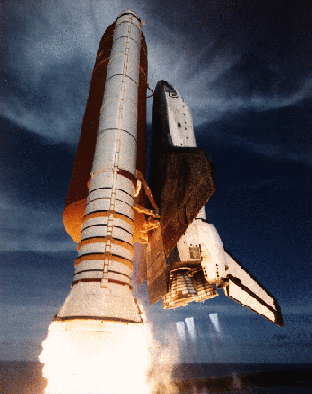
“August 9, 1995 Challenger Launches Spacelab 2 Credit: NASA, Kennedy Space Center Explanation: Space Shuttle Challenger jumps off the launch pad in 1985 to begin a successful mission. The main purpose of this mission was to test a new space based laboratory named Spacelab 2. Spacelab 2 takes advantage of the effectively weightless conditions in orbit to carry out experiments in areas such as astronomy, physics, life science, materials science, and atmospheric physics. Challenger and her crew were lost in 1986 when a booster failure resulted in the breakup of the vehicle. Previously, Challenger and her crews flew nine successful Space Shuttle missions and made significant contributions to America's scientific growth."
Copyright: Public domain
#52 The Orbiting Hubble Space Telescope August 10, 1995
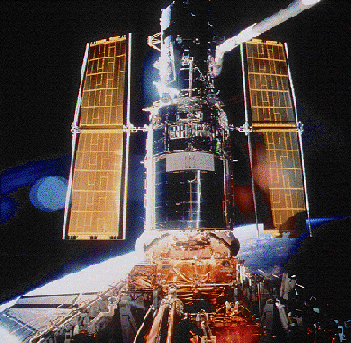
“August 10, 1995 The Orbiting Hubble Space Telescope Credit: NASA, Space Telescope Scientific Institute Explanation: The Hubble Space Telescope (HST) is the largest orbiting public optical telescope in history. Its 2.4 meter diameter reflecting mirror and its perch above Earth's atmosphere allow it to create exceptionally sharp images. Originally launched in 1990, HST optics were repaired to their intended accuracy in 1993 by the first of several regular servicing missions. Astronomers using HST continue to make numerous monumental scientific discoveries, including new estimates of the age of our universe, previously unknown galaxies, evidence of massive black holes in the centers of galaxies, previously unknown moons, and a better understanding of physical processes in our universe."
Copyright: Public domain
#53 The Compton Gamma Ray Observatory August 11, 1995
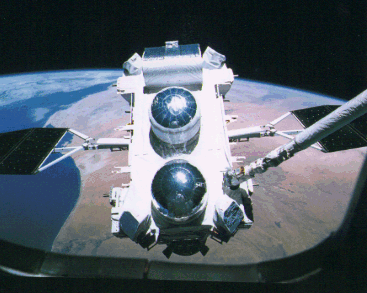
“August 11, 1995 The Compton Gamma Ray Observatory Credit: NASA, Compton Gamma Ray Observatory Science Support Center Explanation: The Compton Gamma Ray Observatory (CGRO) was the most massive instrument ever launched by a NASA Space Shuttle and continues to revolutionize gamma-ray astronomy. This orbiting observatory sees the sky in gamma-ray photons - light so blue humans can't see it. These photons are blocked by the Earth's atmosphere from reaching the Earth's surface. Results from CGRO have shown the entire universe to be a violent and rapidly changing place - when viewed in gamma-rays. Astronomers using CGRO data continue to make monumental discoveries, including showing that mysterious flashes of gamma-rays are much more powerful than previously imagined, discovery of a whole new class of QSO, and discovery of objects so strange that astronomers can't yet figure out what they are."
Copyright: Public domain
#54 Atlantis Landing August 12, 1995
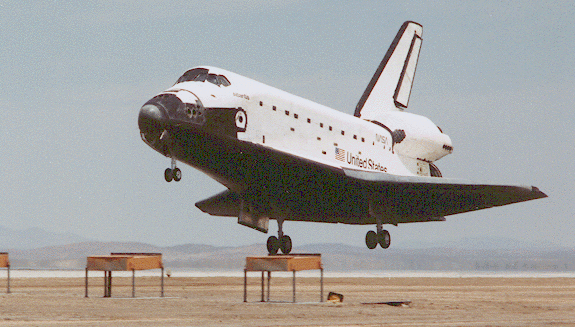
“August 12, 1995 Atlantis Landing Credit: NASA, Kennedy Space Center Explanation: Space Shuttle Atlantis lands at Edwards Air Force Base in California. The Space Shuttle is the first orbital space vehicle to land on a runway like an airplane. Space Shuttles sometimes have the option of landing in White Sands, New Mexico or at the Shuttle Landing Facility at the Kennedy Space Center in Florida. The runways the shuttles land on are among the longest in the world. Shuttles that do not land in Florida must generally be strapped to the back of a 747 airplane and flown back."
Copyright: Public domain
#55 The Sun Erupts August 13, 1995
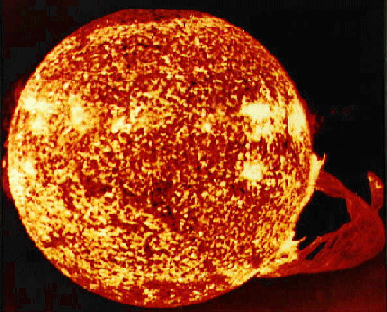
“August 13, 1995 The Sun Erupts Credit: NASA, Skylab Explanation: The sun was captured in 1973 throwing one of the largest eruptive prominences ever recorded. Sol, our sun, is a normal star. It formed about 5 billion years ago, and will last about another 5 billion years. The sun will never explode, and a solar flare will never destroy the earth. Eventually the sun will become a white dwarf star. The sun is made of mostly hydrogen and helium. The sun's center is so hot that when hydrogen nuclei collide, they stick together and release energy - a process called nuclear fusion No one knows why the center of the sun emits so few neutrinos."
Copyright: Public domain
#56 Mercury: Closest Planet to the Sun August 14, 1995
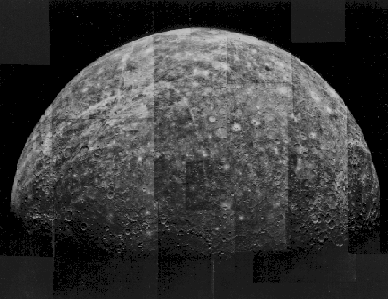
“August 14, 1995 Mercury: Closest Planet to the Sun Credit: NASA, Mariner 10 Explanation: This picture was compiled from images taken by the NASA spacecraft Mariner 10 which flew by the planet three times in 1974. Mercury is the closest planet to the Sun, the second hottest planet (Venus gets hotter), and the second smallest planet (Pluto is smaller). Mercury rotates so slowly that one day there - "day" meaning the normal time it takes from sunset to sunset - lasts 176 days on Earth. It is difficult to see Mercury not because it is dim but because it always appears near the Sun, and is therefore only visible for a short time just after sunset or just before sunrise. Mercury is made of rocky material like Earth. No one knows why Mercury has the magnetic field that it does."
Copyright: Public domain
Upvote! Resteem! Comment! As you like it! Thank you for attention!
They saw true space ulike me. I don't want to live here. The best place for my soul is - cabin in a spaceship. The best view for my eyes - is infinity.